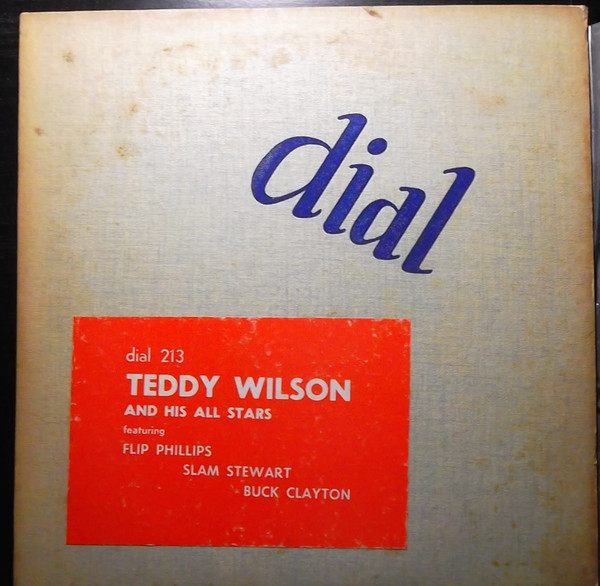第1回 および 第2回 に続き、戦後のレコード製造工程や原材料の歴史、特に 射出成形 と スチレン盤 について改めて調べてみた、そんな記録です。
Following on from the first and second parts, this is a record of a renewed look into the history of postwar record manufacturing processes and raw materials, particularly injection molding and styrene records.
3回目となる今回は、射出成形技術が初めてレコードに使用された1947年から、米巨大レーベルが射出成形に大きな投資を行うことを表明した1950年、さらに1951年〜1953年の朝鮮戦争によるレコード製造原材料不足の時期を、当時の記事などでたどっていくことにします。
This time, the third part, will look back through articles from that time, tracing the period from 1947, when injection molding technology was first used on records, to 1950, when major AMerican labels announced they would be making major investments in injection molding, and then the period from 1951 to 1953, when the Korean War caused a shortage of raw materials for record manufacturing.
当時はありふれた大量生産品であったレコードという製品を作るにあたり、レーベルやプレス工場といった企業にとって、技術面もさることながら、コストに対する意識 と 生産可能速度や効率 が最も重要であった、という至極当たり前のことを、改めて強く認識することとなりました。
This exploration made me keenly aware of the very obvious fact that when it came to producing records, which were a commonplace mass-produced item at the time, companies like labels and pressing plants were most concerned with cost awareness and manufacturing speed and efficiency, in addition to technical aspects.
Contents / 目次
- 「射出成形の到来か?」“Injection Molding’s A-Coming?” (1950, The Billboard)
- 「レコード用プラスチックの供給制限はまだ」 “No Disk Plastics Cut Yet” (1950, The Billboard)
- 「Columbia、新型射出成形金型に向けた製造開始」 “Columbia Gearing To New Injection Molds” (1950, The Billboard)
- 「ヴァイナル供給戦争」 “Vinyl Supply Battle” (1951, The Billboard)
- 「レコード業界の製造コスト、急上昇」 “Diskers’ Production Costs Rise Sharply” (1951, The Billboard)
- 「書籍会社、35¢の Bell レコードをテスト販売」(1952, The Billboard)
- 所感 / Observations
「射出成形の到来か?」“Injection Molding’s A-Coming?” (1950, The Billboard)
今回は、レコードの 射出成形 (Injection Molding) の歴史についてみていきます。
This time, we will look at the history of injection molding of records.
この製造技術がレコードに適用され始めたのは1940年代後半からのようです。
This manufacturing technique seems to have started to be applied to records in the late 1940s.
私が調査した限りにおいて、米国レコード業界誌の最大手 The Billboard 誌 において、射出成形について初めて記事が掲載されたのは、1950年5月13日号 のことでした。
As far as I have researched, the first article about injection molding was published in the May 13, 1950 issue of The Billboard magazine, the largest US record industry magazine.
のちに Billboard 編集者となる評論家 Bill Simon 氏による5月6日付の署名記事「Injection Molding’s A-Coming?: Market Eyes Cheap, Fast Kidisk Method Adoption Soon Possible?」で、新しいレコード製造技術である射出成形にまつわる当時の状況が解説されています。
In a bylined article dated May 6th by Bill Simon, a critic who would later become an editor at Billboard, titled “Injection Molding’s A-Coming?: Market Eyes Cheap, Fast Kidisk Method Adoption Soon Possible?”, he explains the situation at the time surrounding injection molding, a new record manufacturing technology at the time.
1948: 世界初の市販射出成形レコード登場 / The world’s first commercial injection-molded record is released
当記事によると、射出成形をレコード製造に応用したオリジネータは、1946年創業の Bestway Products 社(ニュージャージー州ローウェイ、創業者は Al Massler 氏)で、1947年頃に射出成形レコード製造を実験的に開始したのち、1948年頃から Simon & Schuster 社の子供向けレコードとして市場に投入したようです。
According to the article, the originator of the application of injection molding to record manufacturing was Bestway Products (Rahway, New Jersey), founded in 1946 by Al Massler. They began experimentally manufacturing injection-molded records around 1947, and then brought them to the market around 1948 as children’s records under the company Simon & Schuster.
Injection molding, the rapid, low-cost disk producing method introduced about three years ago with the first experimental Simon & Schuster kidisks, may soon be practical for production of all types of disks the market demands. If so, 10-inch disks could be turned out at about four times the current rate of conventional compression pressing. Seven-inch platters are already being turned out at nearly eight times the old speed.
射出成形は、迅速で低コストのディスク製造方法であり、3年ほど前に Simon & Schuster 社の子供向けレコードで初めて実験的に導入されたが、市場が求めるあらゆるタイプのディスク生産に実用化される日も近いかもしれない。もしそうなれば、10インチ盤は、従来の圧縮成形によるプレスの約4倍の速度で生産可能となる。7インチ盤はすでに、従来の8倍近い速度で生産されている。
“Injection Molding's A-Coming?: Market Eyes Cheap, Fast Kidisk Method Adoption Soon Possible?”, The Billboard, May 13, 1950, p.12 & 41Discogs 上で確認したところ、Simon & Schuster 社が発行した絵本付き6インチ78回転盤、“Scuffy The Tugboat c/w Good Morning” (Golden Records 1, 1948) が、史上初の市販された射出成形レコードということになりそうです。
After checking on Discogs, it appears that the first commercially available injection-molded record in history was the 6-inch 78 rpm record with a picture book, “Scuffy The Tugboat c/w Good Morning” (Golden Records 1, 1948), published by Simon & Schuster.
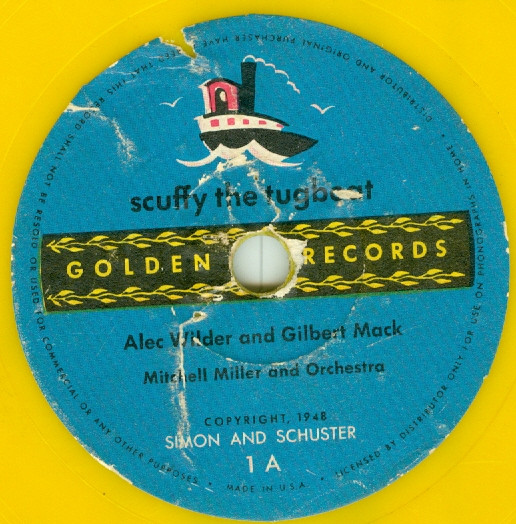
Scuffy The Tugboat c/w Good Morning (Golden Records 1, 1948)
photo from the Discogs entry.
恐らく世界初の市販された射出成形レコード、6インチ78回転盤
明らかにレーベルがプレス後に貼りつけられたのがわかる
1年後の The Billboard 1951年3月31日号 p.17 & 22 の記事「10-Inch Kidisk Line for S&S」では、Simon & Schuster 社が同様の射出成形で製造した10インチ盤のリリースをまもなく開始するべく動いている、と掲載されています。
A year later, The Billboard, Mar. 31, 1951‘s article “10-Inch Kidisk Line for S&S” on p.17 & 22 reported that Simon & Schuster was soon to begin releasing a 10-inch injection-molded record.
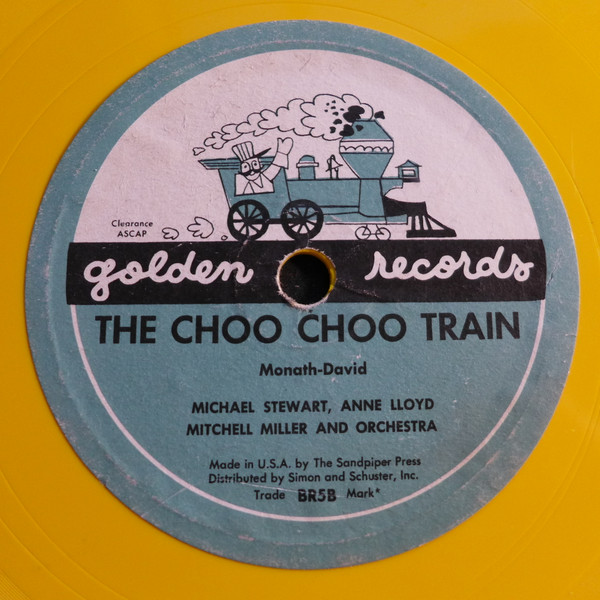
Kalamazoo To Timbuctoo c/w The Choo Choo Train (Golden Records BR5, 1951)
photo from the Discogs entry.
Bestway で射出成形された、最初期の10インチ78回転盤
1950年の記事に戻ります。溶かした原材料を射出成形でモールド(金型)に流し込むには、ポリ塩化ビニルより粘度が低い材料を使うとはいえ、大変な圧力が必要となります。また、10インチや12インチといった大きなサイズで均一な品質での射出成形製造の実用化は当時は困難を極め、6インチや7インチのサイズが限界だったようです。
Back to the article from 1950 – injection molding requires a great deal of pressure to pour molten raw materials into a mold, even though the material used has a lower viscosity than polyvinyl chloride. Furthermore, it was extremely difficult at the time to practically manufacture injection molded products with uniform quality in large sizes like 10 or 12 inches, and it seems that sizes of 6 or 7 inches were the limit.
一方、ポリ塩化ビニル製レコードと比べて品質は劣るけれども製造コストを抑えられるメリットがあるため、まずはあまり品質に敏感にならなくて良い子供向けレコードからの導入、ということだったようです。
On the other hand, although the quality was inferior to PVC records, it had the advantage of lower manufacturing costs, so it seems that the idea was to first introduce it to children’s records, who were not as sensitive about quality.
Low Cost Essential
Since these small-disk lines retail at 25 cents per pressing, low manufacturing cost has been essential. Injection molding advocates point out that this is possible because of multiple presses which permit up to eight seven-inch disks at one time of a single press, and also because of the thermo-plastic material, pre-heated to a molten stage before introduction to the process. In conventional pressing, the material must be heated while on the press. In injection molding, the material is heated up to 500 degrees, then forced into the molds by hydraulic pressure, an all-electronic process.
低コストが不可欠
これらの小型レコードシリーズの小売価格は1プレスあたり25セントであるため、低い製造コストが不可欠である。これが可能なのは、1回のプレスで最大8枚の7インチレコードを製造できるプレス機と、あらかじめ溶融段階まで加熱された熱可塑性材料のおかげだ、と、射出成形の支持者たちは指摘する。従来の(圧縮成形)プレスでは、材料をプレス機上で加熱しなければならない。一方、射出成形では、材料は500℉(= 260℃)まで加熱された上で、電子制御された油圧によりモールド(金型)に押し込まれる。
Lack in Material
Up to now the molders’ big problem has been the development of sufficiently hard material to resist wear, and to afford clear reproduction. They claim to have come a long way in recent months altho, admittedly, the process still doesn’t permit the high frequency range possible in compression pressings.
素材の不足
これまでのところ、成形業者の大きな問題は、摩耗に耐え、クリアな再生を可能にする十分に硬い素材を開発することであった。ここ数ヶ月でかなり進展があったと主張しているが、圧縮成形(による通常のプレス盤)で可能な高周波数帯域を得ることはいまだ達成されていない。
In the kidisk field, however, where full-range recording isn’t deemed too essential, low prices could pull plenty of business. Shelly’s 45-r.p.m. pressings, not made from pure vinyl, are being offered at as low as 12 cents on quantity orders. Vinyl pressings from other plants run about 17 cents. The same plant has set a 26-cent now for 10-inch 3s, while the norm for vinyl disks is around 36 cents.
しかし、フルレンジ録音があまり必須とみなされない子供向けレコードの分野では、低価格により多くのビジネスを牽引できる可能性がある。Shelly 社の45回転盤は、純粋なヴァイナル製ではないが、大量注文の場合は(1枚あたり)12セントという低価格で提供されている。他の工場では10インチ3枚組を26セントに設定しているが、ヴァイナルプレスでは約36セントが普通である。
“Injection Molding's A-Coming?: Market Eyes Cheap, Fast Kidisk Method Adoption Soon Possible?”, The Billboard, May 13, 1950, p.12 & 411回のプレスで最大8枚を生産可能なのは確かにすごいですね。射出成形機は大掛かりな設備で、かつ圧縮成形機に比べて非常に高価ですが、それでも同時に複数枚生産できるのであれば、1枚あたりのコストが下げられることになりますから。
It’s certainly amazing that up to eight pieces can be produced with one press. Injection molding machines are large-scale equipment and are much more expensive than compression molding machines, but if multiple pieces can be produced at the same time, the cost per piece can be reduced.
やはり、製造品質よりも製造コストや製造効率が重要であり、価格競争力を高めたり利益率をあげたりしたい、そんな当時の業界各社の指向が伺える記事となっています。
As expected, manufacturing costs and efficiency were more important than manufacturing quality, and the article gives us a glimpse into the orientation of companies in the industry at the time, who wanted to improve their price competitiveness and increase their profit margins.
1950: Bestway 社と Columbia、射出成形LP開発で緊密な連携 / Bestway & Columbia working closely for producing styrene LP records
この記事が書かれた1950年3月時点では、上の Bestway Products 社のほか、Shelley Products 社(ニューヨーク州ロングアイランド、創業者は Clark Galehouse 氏)も射出成形によるレコード製造を行っていたそうです。また、他のプレス会社も、射出成形のテストを行なっていることが紹介されています。
At the time this article was written in March 1950, in addition to Bestway Products, Shelley Products (Long Island, New York, founded by Clark Galehouse) was also manufacturing records using injection molding. The article also mentions that other pressing companies were also conducting experiments with injection molding.
そして、最も興味深いのが、Bestway Products と Columbia が「7インチ、10インチ、12インチのマイクログルーヴ盤の射出成形に向けて緊密な連携をとっている」と書かれたパラグラフです。マイクログルーヴ盤登場後1年半強、7インチ45回転 + オートチェンジャーを強力に推進する RCA Victor との熾烈なバトルののち、さらに新たなテクノロジに積極的に投資していたことが伺えます。
And the most interesting part is the paragraph that says Bestway Products and Columbia were “working closely with Columbia Records in an effort to apply the process to 7, 10 and 12-inch microgroove disks”. This shows that just over a year and a half after the microgroove record debuted, and after a fierce battle with RCA Victor, which was strongly promoting the 7-inch 45 rpm records with autochangers, they were actively investing in new technology.
また、Shelley Products 社も、10インチ33⅓回転盤のテストプレスを Mercury に提供した、とあり、新技術を多くのレーベルに売り込もうとしていたことが分かります。
It also mentions that Shelley Products provided Mercury with test pressings of 10-inch 33⅓ rpm records, suggesting that they were trying to sell this new technology to many labels.
One injection mold diskery, Shelley Products, Ltd., of Roslyn, L.I.N.Y. is already set up to press 45 and 33⅓ r.p.m. disks at the market’s lowest price for quantity orders. Bestway Products, Rahway, N.J., originator of the process, is working closely with Columbia Records in an effort to apply the process to 7, 10 and 12-inch microgroove disks. Shelley, this week, submitted 10-inch 33⅓ test pressings to Mercury. Bestway, for the past couple of years, has been servicing Simon & Shuster exclusively, producing the Little Golden six-inch line. Recently, however, it has added Columbia as an account, and is producing a portion of that major diskery’s seven-inch playtime 78-r.p.m. kidisk line. Shelley is also doing some of this pressing for Columbia.
ニューヨーク州ロングアイランド、ロスリンの Shelly Products 社は、45回転盤と33⅓回転盤を史上最安値でプレスする体制をすでに整えている。射出成形レコード製造技術の本家本元である、ニュージャージー州ローウェイの Bestway Products 社は、当該成形技術を7インチ、10インチ、12インチのマイクログルーヴ盤に適用すべく、Columbia Records 社と緊密な協力体制をとっている。Shelley 社は今週、10インチ33⅓回転盤のテストプレスを Mercury に提出した。ここ数年、Bestway 社は Simon & Shuster 社に独占的にサービス提供を行い、Little Golden レーベルの6インチ盤を生産してきた。しかし最近になって Columbia を取引先に加え、大手ディスクメーカの子供向け7インチ78回転プレイタイム盤の一部を生産している。Shelley 社もまた、Columbia のために一部のプレスを手掛けている。
“Injection Molding's A-Coming?: Market Eyes Cheap, Fast Kidisk Method Adoption Soon Possible?”, The Billboard, May 13, 1950, p.12 & 41どうやら1950年当時、Columbia を除く米国メジャー・準メジャーレーベル(RCA Victor、Decca、Capitol、Mercury)のうち、Mercury だけがスチレン盤LPに前向きに興味を示していたようです。
Apparently, in 1950, of the major and quasi-major US labels (RCA Victor, Decca, Capitol, Mercury) other than Columbia, only Mercury was showing any interest in styrene LPs.
「レコード用プラスチックの供給制限はまだ」 “No Disk Plastics Cut Yet” (1950, The Billboard)
The Billboard 誌の 1950年8月5日号 では、レコード製造原材料に関する「No Disk Plastics Cut Yet: Manpower Problem Greater」という Ben Atlas 氏の署名記事が非常に興味深いものとなっています。
The Aug. 5, 1950 issue of The Billboard magazine features a very interesting bylined article by Ben Atlas titled “No Disk Plastics Cut Yet: Manpower Problem Greater” about raw materials for record manufacturing.
6月25日に勃発した 朝鮮戦争 による軍事需要増加により、ビニル樹脂やプラスチックの民間使用分の供給制限があるかもしれない、という文脈で、1949年当時のレコード原材料の統計を米国商務省が調査した結果が報告されています。ただし、記事執筆時点においては、ビニル樹脂の生産量は、軍事需要と民間需要の両方に十分足りている、とされています。
The news reports that increased military demand following the outbreak of the Korean War on June 25 may have led to restrictions on the supply of vinyl resin and plastic for civilian use, and that the results of a survey by the U.S. Department of Commerce of statistics on record material from 1949 have been investigated. However, as of the time of writing, vinyl resin production is said to be sufficient for both military and civilian demand.
この記事の中で最も興味深いのは、1949年に米国で製造されたレコードの原材料の種別と比率 について述べる部分です。
- ビニライト盤、すなわちポリ塩化ビニル盤は全体の15パーセント
- 25パーセントはなんらかのビニル樹脂を使った盤
- そして残る6割が従来のシェラック盤
というのが、1949年当時の状況であることがわかります。
The most interesting part of the article is the section that describes the types and proportions of raw materials used in records manufactured in the United States in 1949:
- Vinylite records (PVC records) account for 15 percent of the total
- 25 percent are vinyl records of some kind
- The remaining 60% are traditional shellac records
13,000,000 Pounds in 1949
Commerce estimated that the disk industry used some 13,000,000 pounds of vinyl resins last year in producing about 250,000,000 recordings. About 15 per cent of the 1949 disk output comprised vinylite records, it was estimated, while another 25 per cent of the total production labeled “break-resistant” used some vinyl resins. What Commerce refers to as “shellac-type” disks, comprising about 60 per cent of 1949 production, used only 1,000,000 pounds of shellac and 118,000,000 pounds of various types of synthetic materials all of which were stated to be in “adequate supply” at present.
1949年に6,000トン弱
商務省の推計によると、ディスク産業は昨年(1949年)、約2億5千万枚のレコードの生産のため、約1,300万ポンド(6,000トン弱)のビニル樹脂を使用した。その全生産量のうち約15パーセントがビニライト・レコードであり、約25パーセントは「耐衝撃性」と表示されたなんらかのビニル樹脂を使用していた、と推定されている。商務省が「シェラック・タイプ」と呼ぶディスクは、1949年の全生産量の約60パーセントを占め、たった100万ポンド(約450トン)のシェラック樹脂、そして1億1,800万ポンド(約5万4千トン)の様々な合成樹脂が使用されていた。これらは全て、現在「供給量は十分である」とされている。
Columbia や RCA Victor が当初マイクログルーヴ盤に採用した、おそらく当時としては最も高品質だったビニライト (Vinylite、当時は Union Carbide and Carbon 社の登録商標)以外にも、さまざまな配合のヴァイナルや合成樹脂が使われていたことが伺えます。また、その材料選定における主たる要因は「コストと品質のバランス」であったのでしょう。
In addition to Vinylite (then a registered trademark of Union Carbide and Carbon), which was probably the highest quality material at the time and was initially used by Columbia and RCA Victor for their microgroove records, various vinyl compositions and synthetic resins were also used. The main factor in selecting the material was likely the balance between cost and quality.
また、「耐衝撃性」(break-resistant)と書かれたレコード、というのは、上で触れた Shelley Products や Bestway Products の射出成形レコードのほか、METROLITE (MGM)、SAV-O-FLEX (Savoy)、MERCO PLASTIC (Mercury)、DECCALITE (Decca) などなど、当時の Non-Breakable や Unbreakable と謳われた78回転盤などを指すのでしょう。
Furthermore, records labeled as “break-resistant” likely refer to the injection-molded records of Shelley Products and Bestway Products mentioned above, as well as 78 rpm records that were advertised as non-breakable or unbreakable at the time, such as METROLITE (MGM), SAV-O-FLEX (Savoy), MERCO PLASTIC (Mercury), DECCALITE (Decca), and others.
そして、これら「耐衝撃性」と謳われた当時の盤に使われた材料や組成は、おそらくどれも企業秘密であったのでしょう。
Also, the materials and compositions used in these records that were advertised as “break resistant” at the time were probably all trade secrets.
Deccalite を例にとると、初期はヴァイナル比率を下げた組成と思われる盤の呼称として使われ、のちにスチレン盤の呼称としても使われていたことが知られているため、特定の樹脂や混合物を指した呼称でなく、あくまで販売用キャッチフレーズであった可能性も高そうです。
Taking Deccalite as an example, it is known that it was initially used to refer to records that were thought to have a lower vinyl content, and later to refer to styrene records. Therefore, it is highly likely that it was merely a marketing slogan rather than a name referring to a specific resin or mixture.
そして、商務省は、この記事の「なんらかのヴァイナル」の中に、ポリスチレンも含めてカウントしていた可能性はありそうです。
And it’s possible that the Commerce Department included polystyrene in the “vinyl of some kind” count in this article.
![[METROLITE]](https://microgroove.jp/img/MetroLite.jpg)
![[MERCO PLASTIC]](https://microgroove.jp/img/MercoPlastic.jpg)
![[SAV-O-FLEX]](https://microgroove.jp/img/SavOFlex.jpg)
![[SAV-O-FLEX]](https://microgroove.jp/img/Deccalite.jpg)
なお、当記事では、生産資材の問題よりも、朝鮮戦争による徴兵による人手不足の方が、ディスク業界にとって深刻となる可能性がある、と述べていることにも触れておきます。
It should also be noted that the article states that the labor shortage caused by conscription during the Korean War could be more serious for the disc industry than issues with production materials.
「Columbia、新型射出成形金型に向けた製造開始」 “Columbia Gearing To New Injection Molds” (1950, The Billboard)
そして、1950年8月にやっと「回転速度戦争」に 終止符を打った ばかりの、当時の米国2大レーベル RCA Victor と Columbia、この両者が、今度はレコード製造技術で対立する可能性が高まってきました。
And while the two major American labels at the time, RCA Victor and Columbia, had only just put an end to their “Battle of the Speeds” in August 1950, it was becoming increasingly likely that they would now come into conflict over record manufacturing technology.
The Billboard 誌の 1950年11月4日号 には、スッパ抜き記事「Columbia Gearing To New Injection Molds: It’s A Hush-Hush as Process Gets Kicked Around by Experts」が掲載されました。ついに Columbia が射出成形技術開発および設備設置に巨大投資 を行う、というものです。
The Nov. 4, 1950 issue of The Billboard magazine carried the revealing article “Columbia Gearing To New Injection Molds: It’s A Hush-Hush as Process Gets Kicked Around by Experts”, announcing that Columbia was finally making a huge investment in developing injection molding technology and installing equipment.
当記事によると、射出成形機を開発・製造している M & W 社と Columbia が射出成形機を共同開発し自社プレス工場に設置、45回転盤製造を開始した、とあり、また 両社は10インチおよび12インチのLPも射出成形で製造できるよう、さらに追加投資を行なっていると報じられています。
According to the article, M & W, a company that develops and manufactures injection molding machines, and Columbia have jointly developed an injection molding machine, installed it at their own pressing plant, and begun producing 45 rpm records.The article also reports that the two companies are making additional investments to enable the production of 10-inch and 12-inch LPs using injection molding.
さらに、射出成形で先行する Bestway Products 社も M & W 社の射出成形機を使用していると伝えられています。
Additionally, Bestway Products, a leader in injection molding, is reportedly using M&W injection molding machines.
NEW YORK, Oct. 28 — Tho making every effort to keep any word of the operation from leaking out, Columbia Records is gearing toward a new method of manufacturing its disks — the injection molding process. In conjunction with the M & W Company, a New Jersey development engineering firm, the diskery has developed an injection molding machine made especially to manufacture disks, and is turning out 45 r.p.m. records by this process. It is reported that they are investing in several more such machines for the production of 10 and 12-inch LP’s.
ニューヨーク発、10月28日 — 情報が漏れないようにあらゆる努力をしている Columbia Records だが、ディスク製造の新方式である射出成形工程に取り組んでいる(ことが明らかとなった)。同社は、ニュージャージーの開発エンジニアリング会社である M & W 社と共同でディスク製造専用の射出成形機を開発し、45回転盤の生産を行なっている。同社は10インチおよび12インチのLP盤の製造に向けて、さらに数台の同様の機器に投資していると報じられている。
“Columbia Gearing To New Injection Molds”, The Billboard, November 4, 1950, p.16 & 24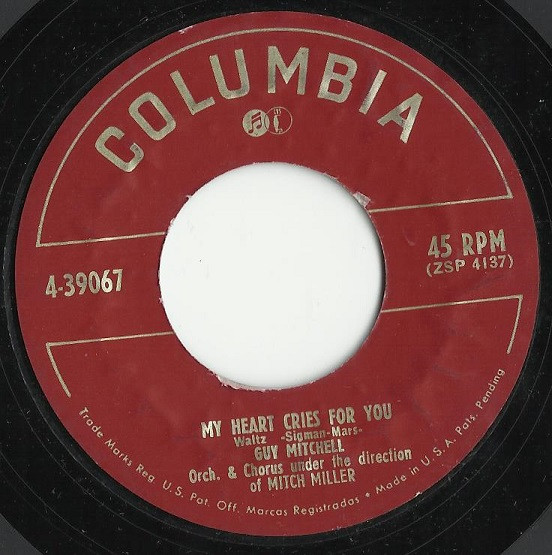
My Heart Cries For You c/w The Roving Kind / Guy Mitchell
source: Discogs entry.
1950年リリース、最初期の Columbia 射出成形スチレン45回転盤
なお、M & W 社は、1950年12月28日提出、1953年6月23日登録の「2,642,621 “Apparatus and Method for Producing Disk Phonograph Records”」として、レコード射出成形機および製造方法を特許としています。
M & W also holds a patent for a record injection molding machine and manufacturing method, filed on December 28, 1950 and registered on June 23, 1953, under the title “2,642,621 ‘Apparatus and Method for Producing Disk Phonograph Records’”.
また、Columbia 以外の各レーベルは、射出成形によるレコード製造実験をすでに行なってはいるものの、10インチ以上への適用には依然解決すべき問題があると考えている、と伝えます。
The article also reports that while labels other than Columbia had already experimented with injection-molded record manufacturing, they believed there were still problems to be solved when it comes to applying the method to 10-inch and larger records.
一方 Columbia は、問題解決はすぐにできるはずだから技術開発に投資を惜しまない、というスタンスであると記事にあり、他レーベル(特にライバル RCA Victor)より有利な立場につこうとしていたことが伺えます。
On the other hand, the article states that Columbia was taking the stance that they would not hesitate to invest in technological development because they believed the problem could be solved quickly, suggesting that they were trying to gain an advantageous position over other labels (especially their rival RCA Victor).
While Columbia execs remain mum on all aspects of the venture, disk engineers and execs of other major waxeries admit that almost all the majors have been experimenting with the new process. The consensus outside Columbia is that injection molding may some day be the one way in which platters will be produced, but the estimate is that, as an industry-wide method, it is from two to 10 years away. The reason for this, they say, is that important bugs in the process have yet to be licked.
Columbia 幹部は、この事業に関するあらゆる側面について沈黙を守っているが、ディスクエンジニアや大手他社幹部は、ほぼ全ての大手レーベルがこの新製造方法を実験していることを認めている。将来、射出成形がレコード製造のいち方法となるだろう、というのが Columbia 社外でのコンセンサスであるが、業界全体としては2年〜10年先のことであろう、と見込まれている。その理由として、製造工程において重大な欠陥があり、それがまだ解決されていないためである、とは彼らの弁である。
It is believed that Columbia and its engineers feel otherwise; that injection molding of all sizes of LPs (and the 45 r.p.m.’s) is close on the horizon. If Columbia has worked out the bugs, it is in a position to be the first to make an important technological change in disk manufacturing, and to benefit accordingly.
一方、Columbia とその技術者はそうではなく、あらゆるサイズのLP盤(および45回転盤)の射出成形が近い将来実現可能と考えていると思われる。もし Columbia がその欠陥を解決することになれば、ディスク製造における重要な技術的変化を起こす最初の企業となり、それに応じて利益を得るポジションにつくことになる。
“Columbia Gearing To New Injection Molds”, The Billboard, November 4, 1950, p.16 & 24そして当記事では、射出成形のメリット が複数挙げられています。
The article goes on to highlight several advantages of injection molding.
従来の圧縮成形によるプレス機より10倍ものコストを要する射出成形機であっても、(1) ヴァイナルより安いプラスチックであるポリスチレンの使用、(2) 半自動または全自動での動作、さらに一度に6枚を同時に製造できることから、製造速度の圧倒的な向上、(3) 人件費の大幅な削減、(4) 圧縮成形よりスタンパーへの負荷が低いので、スタンパーがより長期間使用できること、あるいはメタルマスターをそのままスタンパーとして使用も可能であること、など、やはりコスト面でのメリットが強調されています。
Even though injection molding machines cost 10 times more than traditional compression molding presses, the article emphasizes the cost benefits, including: (1) the use of polystyrene, a plastic that is cheaper than vinyl; (2) semi-automatic or fully automatic operation, and the ability to produce six discs at a time, dramatically improving production speed; (3) significant reductions in labor costs; and (4) the lower load on the stamper compared to compression molding, allowing the stamper to be used for a longer period of time, or the ability to use a metal master as a stamper itself.
一方、射出成形のデメリット についても触れられていて、(1) プレス時にレーベルをセットできないので、射出成形後に別途レーベルを貼り付ける追加工程が必要である(人件費増となる)こと、(2) ポリスチレン盤はヴァイナル盤より再生品質がはるかに劣るうえ、戦時優先物質であるベンジンを使用するため、スチレン類の不足が危惧されること、などが挙げられています。
The report also touches on the disadvantages of injection molding, citing that (1) since labels cannot be set during pressing, an additional process of attaching a label after injection molding is required (increasing labor costs), and that (2) the playback quality of polystyrene records is far inferior to that of vinyl records, and that since polystyrene records use benzine, a wartime priority substance, there are concerns about a shortage of styrene.
本記事では最後に、現状でのデメリットを認識した上で、それでも Columbia が射出成形に投資する背景について述べています。
The article concludes by explaining why Columbia decided to invest in injection molding, despite recognizing the current disadvantages.
First people to use the new process on a large scale were Simon & Schuster with their little Golden records. Columbia followed suit with their Playtime minidisks, made for them by Shelley Products, a Long Island manufacturer. Next, Columbia used and is using the process for its 45’s. But, say the critics, reliable results have not been obtainable with the larger surfaced 10 and 12-inch records, which, they claim, cool unevenly, cracking and warping. Whether Columbia and M & W have solved the difficulties for the large disks only they can know — it is hinted that they have.
この新しい製造方法を最初に大規模に使用したのは、Simon & Schuster 社の Little Golden Records であった。Columbia は、ロングアイランドのメーカ、Shelley Products が製造した(子供向けの)Playtime ミニレコードでこれに続いた。そして Columbia は 45回転盤向けにこの製造法を使用し、現在も継続中である。しかし、評論家によると、表面積がより大きく、冷却が不均一で、ひび割れや反りが生じやすい10インチや12インチのレコードでは、信頼できる結果がまだ得られていない、という。Columbia と M & W 社が、大型レコードの問題を解決したかどうかは、両社のみ知るところであるが、おそらくは解決したのであろうと思われる。
It is bruited that Columbia has made a big investment in the process, staking a great deal on its outcome. If it succeeds, they can be out in front. If costs keep rising, the new method may enable them to keep their LP prices at present levels; if costs drop, they may be able to reduce their prices ahead of everyone else.
Columbia はこの製造方法に多額の投資を行い、その結果に多大なる賭けをしている、と噂されている。もしこれが成功したならば、Columbia は先頭に立つこととなるだろう。コストが上昇し続ければ、この新しい製造方法により、Columbia はLPの価格を現在のレベルに維持できるかもしれない。コストが下がった場合でも、Columbia は他社に先駆けて価格を下げることができる可能性がある。
Other companies are said to own injection molding machines, but none of the type designed specifically for platter manufacture. Victor and Decca admit to experiment and investigation in the process; Mercury has already turned out some LPs by the new process.
他社も射出成形機を所有していると言われているが、レコード製造専用に設計されたものではない。Victor と Decca は、射出成形で実験と調査を行なっていることを認めている。また Mercury はすでに、この新しい製造方法で一部の LP 製造を行なっている。
In any event, the industry obviously feels there’s something in the wind — obvious because of the hush-hush response to questions in all quarters.
いずれにせよ、業界は明らかに何かが起こっていると感じている。あらゆる方面からの質問に対して口をつぐんでいることからも、それは明らかである。
“Columbia Gearing To New Injection Molds”, The Billboard, November 4, 1950, p.16 & 24この記事では、Mercury が射出成形盤を採用している、と書かれていますが、これは子ども向けリリースの Mercury Childcraft / Playcraft なのかもしれません。いずれにせよ、以下の Dreyhaupt 氏へのインタビューを読み解くに、Mercury が自社プレス工場で射出成形盤を作っていた可能性がありそうです。
The article states that Mercury used injection-molded discs, which may refer to the children’s releases, Mercury Childcraft / Playcraft. In any case, the following interview with Dreyhaupt suggests that Mercury may have been making injection-molded discs in their own pressing plant.
2025/11/02 追記:本稿 Pt.6 にて、Mercury は1950〜51年頃から10インチの射出成形スチレン盤を製造・販売していたことを確認しました。
Update (Nov. 2, 2025) : In Pt.6 of this article series, I confirmed that Mercury was manufacturing and selling 10-inch injection-molded styrene discs since around 1950-1951.
Mercury が Bestway や Shelley の技術を借用?剽窃?していた可能性もあり、以下のコラムに出てくる「Shelley と Mercury の仲違い」というのは、そのあたりに関係していたのかもしれませんね。
It’s possible that Mercury borrowed or plagiarized technology from Bestway and Shelley, and “(Shelly) had a falling out with them (Mercury)” mentioned in the following column may have been related to this.
私が 出版直後に購入した John Broven 氏の大作、「Record Makers and Breakers — voices of the independent Rock ‘n’ Roll Pioneers —」(2009) に、Shelley Products のプレス工場マネージャ Joe Dreyhaupt 氏に行なった2000年のインタビューが引用されており、非常に貴重な情報となっています。以下、当該部分を引用します。
John Broven’s magnum opus, “Record Makers and Breakers — Voices of the Independent Rock ‘n’ Roll Pioneers —” (2009), which I purchased shortly after its publication, includes a quote from a 2000 interview with Joe Dreyhaupt, manager of the pressing plant at Shelley Products, which is extremely valuable information. Quoting the relevant part below:
Fascinatingly, Joe Dreyhaupt remembered being told by Galehouse that in developing the automatic injection molded idea, he worked “in collusion with somebody from Mercury Records who was trying to do the same thing.” It could possibly have been Irving Green, “but Clark had a falling out with them [Mercury].”
素晴らしいことに、(Shelly Products プラントマネージャの) Joe Dreyhaupt 氏は、(Shelly 創業者の) Galehouse 氏から言われたことを記憶していた。それは「同じようなこと(射出成形によるレコード製造)をやろうとしていた Mercury Records の誰かと結託して進めていた」というものであった。Mercury の誰かとは、おそらくは Mercury 創業者の Irving Green 氏の可能性もあるが、同時に「Mercury とは結局喧嘩別れした」とも言っていたそうである。
The mechanics of the prototype injection-molding machine at Shelley Products, as well as the early trials and errors, were described by Dreyhaupt.
Shelley Products 社で試作された射出成形機の仕組みや初期の試行錯誤について、Dreyhaupt 氏が解説をしてくれた。
The labels were impressed into the records. Then, hydraulically, pins would move up and puncture the center of the record, it would retract, and the mold would open. A great big air-operated retriever arm would come in with four suction cups on it, pick up the four records, [and] bring them out. That was the theory: you’d drop four records in four separate boxes. With the very first machine, it didn’t work too well. It was kind of clumsy operation; it was slow. It was hard to control the molding process — it made a lot of rejects — but it lent itself very well to 45s, finally.
(プレス後に)レーベルはレコードに押し付けられた。その後、油圧でピンが動き、レコードの中央に穴を開けると、ピンは引っ込み、金型が開く。大きなエア駆動のリトリーバーアームが4つの吸盤を付けて入ってきて、4枚のレコードを拾い上げて取り出す。それがセオリーだった。4枚のレコードを4つの別々の箱に入れる。最初の機械はあまりうまくいかなかった。動作が不器用で、遅かった。成形工程をコントロールするのが難しく、不良品がたくさん出た。
With the conventional compression system, the timing of that operation was very important; otherwise, it would warp or dish the record. The majority of 45s were still produced by compression molding. Finally, and automated compression-molding machine was invented that would make two 45s at one time, but the speed would not compare with ours.
従来の圧縮成形では、その操作のタイミングがとても重要だった。そうしないと、レコードが歪んだり凹みができたりするんだ。ついに、一度に2枚の45回転盤を作る自動圧縮成形機が発明されたが、スピードは私たちの比ではなかった。
Up until the time that we put in the compression-molding machines with a vinyl operation, we were trying to make ten-inch and twelve-inch records by injection molding machines. That was a disadvantage; it did not lend itself well to those formats. Mercury Records made injection-molded large records; Columbia Records also did it. But we were were able to custom-mold for Columbia Records for 45s because they were used to injection-molded polystyrene records. With 45s, injection-mold polystyrene was automated and quicker. You could operate it with very little labor.
圧縮成形機を導入するまでは、我々(Shelley Products プレス工場)は射出成形機で10インチや12インチのレコードを作ろうとしていた。これは不利な点だった。なぜなら(射出成形法は)これらのフォーマットには適していなかったからだ。Mercury は射出成形の大型レコードを作っていたし、Columbia もそうだった。しかし、Columbia はポリスチレンの射出成型レコードに慣れていたので、我々は Columbia 向けの45回転盤製造委託を受けられた。45回転盤の場合、ポリスチレンの射出成形は自動化され、より短時間で成形できた。最小限の労働力で操作可能だった。
“Record Makers and Breakers”, John Broven, University of Illinois Press, 2009, pp.382-384「ヴァイナル供給戦争」 “Vinyl Supply Battle” (1951, The Billboard)
The Billboard 1951年1月27日号 では、上の記事でも触れられていた朝鮮戦争により、レコードの各種原材料が戦時優先物質となり、原材料製造メーカがレコード製造メーカ(プレス工場など)に十分に供給できていない現状を伝える記事「Vinyl Supply Battle: Chemists See Possible Ease by Year’s End; Swap Plan on Aid」が掲載されています。
The Jan. 27, 1951 issue of The Billboard carried an article titled “Vinyl Supply Battle: Chemists See Possible Ease by Year’s End; Swap Plan on Aid”, which reported that due to the Korean War, which was also mentioned above, various raw materials for records had become wartime priority materials, and raw material manufacturers were unable to supply enough to record manufacturers (such as pressing plants).
この記事では、ビニル樹脂を製造する主要メーカ、B.F. Goodrich 社、Union Carbide & Carbon 社の Bakelite 部門、Goodyear Tire & Rubber 社について触れ、政府からの受注が増えることで民間への供給量が減り、特にビニル樹脂の原材料となる塩素と酢酸ビニルの不足が深刻であると述べています。
The article mentions three major vinyl resin manufacturers: BF Goodrich, Union Carbide & Carbon’s Bakelite division, and Goodyear Tire & Rubber. It states that increased government orders have reduced supplies to the private sector, resulting in a particularly serious shortage of chlorine and vinyl acetate, the raw materials used to make vinyl resin.
また、商務省国家生産局 (NPA, National Production Authority) はこの問題を解決すると発言しているものの、当記事執筆時点においては特に有効な手立ては打たれていない、と記されています。
The article also notes that while the Ministry of Commerce’s National Production Authority (NPA) has stated that it will resolve the issue, no effective measures have been taken at the time of writing.
そのため、戦況により状況が悪化した場合には、レコード製造メーカやレーベルは、第二次世界大戦の時のように、新規注文に際して相応の古い盤(中古盤、破損盤、過剰在庫など)をリサイクル用に提供する必要が生じるかもしれない、とレコード製造メーカに注意を呼びかけています。
Therefore, record manufacturers and labels are being warned that if the situation worsens due to the war situation, they may be required to provide a proportion of old records (used, damaged, excess stock, etc.) for recycling when placing new orders, as was the case during World War II.
本記事の最後には、ヴァイナルの代替物質についても触れられており、ここでかつてのレコード主要原材料であるシェラックの話と、ポリスチレンについての話が出てきます。
The end of the article also touches on alternatives to vinyl, including shellac, the former main material used in records, and polystyrene.
Substitutes
As for substitutes for vinyl, record pressers are searching for one that would be as good as the material now used, but no great success is promised. SInce vinyl records can be reused, some easing of the squeeze may be the return of used, scratched, broken or overstocked records.
代替物質
ヴァイナルの代替として、レコード製造業者は現在使われている素材と同等のものを探しているが、大きな成功は約束されていない。ヴァイナルレコードは再利用可能であるため、使用済レコード、傷ついたレコード、壊れたレコード、在庫過剰のレコードが戻ってくることで、多少の圧迫が緩和される可能性がある。
The shellac industry, once the all-important suppliers of record pressing material, is ready and able to step into the business. Industry spokesmen say they will have a steady supply of shellac as long as the sea routes to the East remain open. However, alcohol, the shellac solvent, is also a critical defense item.
かつてはレコードプレスの原材料として重要な役割を担っていたシェラック業界も、このビジネスへの参入準備ができている。業界のスポークスマンによると、東洋への海路が開かれている限りは、シェラックの安定供給は可能である、という。しかし、シェラックの溶剤であるアルコールもまた、重要な防衛アイテムである。
The future of injection molding for records also appears to be dim. The basic material used for injection molded disks, polystyrene, is one of the most critical of all plastics.
射出成形レコードの将来も暗いようだ。射出成形盤の主たる原材料であるポリスチレンは、プラスチックのなかで最も危機的な(供給)状況にある素材である。
“Vinyl Supply Battle: Chemists See Possible Ease by Year’s End; Swap Plan on Aid”, The Billboard, January 27, 1951, p.12 & 771951年3月3日号 には、レコードプレス機の金型業者 Barnaby Manufacturing 社の広告が掲載されています。7インチ〜16インチ、圧縮成形用/射出成形用のレコード金型と書かれていますが、その下に「まだ供給可能」「政府の規制により、供給源がいつ閉鎖されるか不明である」と但し書きがあるのが、この朝鮮戦争の時期の業界の不安定さを表しているようです。
The Mar. 3, 1951 issue contains an advertisement for Barnaby Manufacturing, a manufacturer of molds for record pressing machines. The advertisement lists molds for 7-inch to 16-inch records, for compression molding and injection molding. However, underneath the advertisement there is a disclaimer that reads, “still able to supply you” and “Government restrictions may close our sources of supply any day” which seems to reflect the instability of the industry during the Korean War.
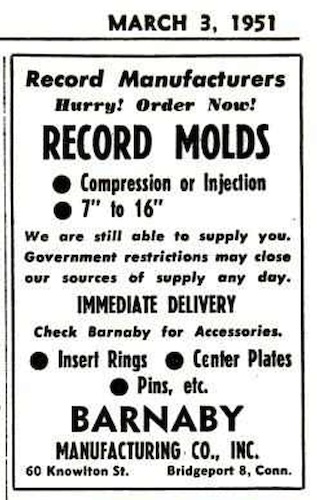
source: The Billboard, March 3, 1951, p.32.
1951年3月17日号 の記事「’51 Record Outlook For Ops Brightens: Industry Should Be Able To Get Record Supply During Emergency」では、ポリスチレンと射出成形という「まだ生まれたての段階」の新技術について、また戦時体制での原材料不足の懸念に対して、ポリスチレンの代替物質の開発、あるいは充填材開発によるビニライトやポリスチレンの節約など、業界が協力して乗り越えるだろう、といった楽観的な予測を記しています。
The Mar. 17, 1951 issue‘s article, “’51 Record Outlook For Ops Brightens: Industry Should Be Able To Get Record Supply During Emergency” optimistically predicted that the industry would work together to overcome concerns about raw material shortages during the war, such as developing substitutes for polystyrene or developing fillers to conserve Vinylite and polystyrene.
Injection molding — one of the newer developments in the production of phonograph records — is still in such an infant stage that the future possibilities are near-amazing. And while it is true that the injection molders now require the plastic Polystyrene it is also quite true that such important firms as RCA Victor, Decca and Union Carbide are working in unison to develop a substitute material for the vital Polystyrene.
射出成形は、レコード製造における新しい開発の1つであるが、まだ発展途上の段階であり、将来の可能性は驚くべきものに近いと言ってよい。現在、射出成形業者がポリスチレンというプラスチックを必要としているのは事実であるが、RCA Victor、Decca、Union Carbide といった重要な企業が一体となって、射出成形製造に不可欠なポリスチレンの代替材料の開発に取り組んでいるのもまた事実である。
Further, on the development of materials, it is now known that record manufacturers have come up with “extenders” and “fillers” — less technically described as way of making a pound of Vinylite or other such materials go further.
さらに、材料開発に関しては、レコード製造業者がビニライトやその他の原材料を少しでも節約するための方法として「増量剤」や「充填材」といった、専門的にはあまり説明されていない材料を考え出したことも知られている。
“'51 Record Outlook For Ops Brightens: Industry Should Be Able To Get Record Supply During Emergency”, The Billboard, March 17, 1951, p.78「レコード業界の製造コスト、急上昇」 “Diskers’ Production Costs Rise Sharply” (1951, The Billboard)
The Billboard 1951年12月15日号 では、この1年でレコード製造コストがかなり上昇した、と伝える「Diskers’ Production Costs Rise Sharply: Recording, Pressing Status Quo, But Other Prices Jump 15 to 30 Per Cent in Year」という記事が掲載されています。
The Dec. 15, 1951 issue of The Billboard features an article titled “Diskers’ Production Costs Rise Sharply: Recording, Pressing Status Quo, But Other Prices Jump 15 to 30 Per Cent in Year” which reports that record manufacturing costs have risen significantly over the past year.
当記事によると、プレス料金にほとんど変化はないものの、ジャケットや印刷コストが最大30パーセント上昇したことで、特にマイナーレーベルではライナーノーツを廃止したり、ジェネリックジャケにしたりするなどして、コスト増に対応しようとしていたそうです。
According to the article, while pressing fees have remained largely unchanged, jacket and printing costs have risen by up to 30 percent, leading some minor labels in particular to try to cope with the increased costs by eliminating liner notes or using generic jackets.
One year ago, an LP envelope in 1,000 quantities sold for about 6 or 7 cents. Today the price is nearer to 10 cents. Four pocket 78 rpm albums that cost 17 cents in 1950 are now about 20 cents. Altho printing costs rose only by about 10 per cent, the higher prices charged for set-up and typography has made many a small manufacturer eliminate the liner that usually is on LP envelopes and albums.
1年前、LPジャケ用の封筒は、1,000枚ボリュームでの注文の場合、1枚あたり約6〜7セントで販売されていた。現在ではその価格は10セント近くとなっている。4枚組78回転盤アルバム(のジャケット)は、1950年には17セントであったが、現在は約20セントである。印刷コストは10パーセント程度しか上昇していないが、活字のセットアップに課す価格の上昇により、多くの小規模レーベルがLPジャケットやアルバムに通常ついているライナーノーツを廃止している。
In order to beat the high cost of printing, a number of independent LP firms use a standard cover for all LP’s, and merely paste on a gummed sticker to identify new releases. This eliminates being stuck with envelopes for LP’s that do not move.
印刷コストの高騰を抑えるため、多くのインディーLPレーベルはすべてのLPに標準ジャケットを使用し、新しいリリースを識別するためにステッカーを糊付けするだけにしている。これにより、在庫が動かないLP用のジャケットに悩まされることがなくなる。
“Diskers' Production Costs Rise Sharply”, The Billboard, December 15, 1951, p.15この「標準ジャケットにステッカーを糊付け」といえば、私は一時期の Dial レーベルの10インチLPを思い出してしまいました。
This “standard cover with a gummed sticker” reminds me of the 10-inch LPs on the Dial label.
また、1951年暮れ時点での、プレス料金についても触れられています。
The article also mentions pressing fees as of the end of 1951.
Pressing charges have not risen, and in same cases have even fallen a bit below last December. This is due to the heavy competition in the pressing field and the fact that threatened shortages of shellac or vinylite did not develop as anticipated. Prices for records today run about the same as last year, with 78 rpm shellac at 15 cents to 18 cents, break-resistant 78’s and 10-inch LP’s at 22 cents to 28 cents, vinyl-filled records at 28 cents to 32 cents, and pure vinylite records at 33 cents and up.
プレス料金は据え置かれたままで、昨年12月よりも少し下がったケースもみられる。これは、プレス分野での激しい競争のせいでもあり、またシェラックやビニライトの不足という脅威が危惧されたほど進まなかったためでもある。今日のレコードプレス料金は昨年とほぼ同じであり、78回転シェラック盤は15〜18セント、割れにくい78回転盤と10インチLPは22〜28セント、ヴァイナル入りレコードは28〜32セント、純粋なヴァイナルレコードは33セント以上である。
“Diskers' Production Costs Rise Sharply”, The Billboard, December 15, 1951, p.15ここで非常に興味深いのは「ヴァイナル入りレコード」(vinyl-filled records)と「純粋なビニライトレコード」(pure vinylite records)が明確に区別されていることです。
What’s really interesting here is the clear distinction between “vinyl-filled records” and “pure vinylite records”.
つまり、品質的な問題が増す可能性があるが、ビニライト(に代表されるポリ塩化ビニル)にいろんな混ぜ物がされた、コスト対策が行われたレコードが、マイクログルーヴ盤登場直後である1950年頃にはすでに普通に製造され、流通していた、ということになります。おそらく、本稿 Pt.2 で紹介した Humfeld 氏の解説記事 にあった、「ヴァイナルの10%までを増量剤(希釈材)で置換可能」がこれに相当するのでしょう。
In other words, although there was a possibility of increased quality issues, cost-effective records made with various additives added to Vinylite (and other polyvinyl chloride) were already being commonly manufactured and distributed around 1950, just after the introduction of microgroove records. This is probably what Hummeld’s commentary article (see: Pt.2) said, “(extender materials) can be used to replace up to about 10% of the vinyl resin to give a cost reduction”.
そして、この1951年暮れの時点では、おそらくポリスチレン製射出成形12インチLPはまだ存在していなかったはずですので、本記事の「ヴァイナル入りレコード」の中にはスチレン盤は含まれておらず、廉価盤向けの低品質なヴァイナル盤を指していると考えるのが自然と思われます。
And at the end of 1951, injection-molded polystyrene 12-inch LPs probably didn’t exist yet, so it’s natural to assume that “vinyl records” in this article don’t include styrene records, and that they refer to low-quality vinyl records aimed at budget releases.
いずれにせよ、このように、1950年6月25日に朝鮮戦争が勃発し、1953年7月27日に休戦協定が締結されるまでの間、米国のレコード製造業界はいつ不安定になってもおかしくない状況に置かれていたこと。さらにその時期が、まさにマイクログルーヴ盤の普及初期、そして射出成形ポリスチレン盤という新技術登場時期と、見事に重なり合っていたこと。そのことを再確認させられます。
In any case, this article reminds us that from the outbreak of the Korean War on June 25, 1950, until the signing of the Armistice on July 27, 1953, the US record manufacturing industry was in a state of uncertainty at any time. Furthermore, this period coincided perfectly with the early spread of microgroove records and the emergence of the new technology of injection-molded polystyrene records.
「書籍会社、35¢の Bell レコードをテスト販売」(1952, The Billboard)
The Billboard 誌 1952年11月29日号 には、射出成形の最も最初期の採用例である Simon & Shuster 社、および Golden Records レーベル のオーナーである Arthur Shimkin 氏が新たに立ち上げた Bell Records がやはり Bestway Products 製の射出成形盤を採用し、7インチ78回転盤のリリースを 35セントという超廉価でスタートする、という記事が掲載されています。
The November 29, 1952 issue of The Billboard magazine carried an article reporting that Arthur Shimkin, owner of the Simon & Shuster, one of the earliest adopters of injection molding, and the Golden Records label, launched a new label Bell Records. It also reports that the new label was also using injection-molded records made by Bestway Products and would begin releasing 7-inch 78 rpm records at the extremely low price of 35 cents.
NEW YORK. Nov. 22. — Cloaked with a maximum of secrecy, a new line of pop records selling for 35 cents a disk is being quietly tasted in a few stores in and around New York. This new label, called Bell Records, in owned by PocketBooks, Inc., and is the book publisher’s first venture as a record producer. The firm has, however, considerable experience in record distribution, serving as distributor for Golden Records, the kidisk line produced by Simon & Schuster.
ニューヨーク発、11月22日 — 極度の秘密主義に包まれながら、1枚35セントで販売されるポップレコードの新商品が、ニューヨーク近郊の数店舗でひっそりと試聴されている。Bell Records と名付けられたこの新レーベルは、PocketBooks が所有するもので、書籍出版社としてはレコード・プロデュースを行う初のベンチャーである。しかし同社は、Simon & Schuster 社が製造する子供向けレコードシリーズ、Golden Records のディストリビュータを務めるなど、レコード流通ではかなりの経験を持っている。
The new Bell label is a seven-inch. semi-microgroove 78 r.p.m. disk that plays the same amount of music as the normal 10-inch record. The discs are produced by injection molding by Bestway Products in Rahway, N.J., a pioneer in the field of Injection molding. Bestway also molds Golden Recerds for Simon & Schuster.
この新しい Bell レーベルは、7インチのセミ・マイクログルーヴ78回転盤で、通常の10インチ盤と同等の収録時間となっている。このレコードは、射出成形のパイオニアである、ニュージャージー州ローウェイの Bestway Products 社による射出成形で製造されている。Bestway 社はまた、Simon & Schuster 社の Golden Records の盤も製造している。
“NEW LOW-PRICE POPS: Book Firm Tests 35c Bell Records”, The Billboard, November 29, 1952, p.19また、当記事では、現在は実験段階ではあるが、ゆくゆくは Bell は3スピード(78回転、45回転、33⅓回転)の全てでリリースする予定である、と記されています。また、1枚35セントという超廉価で利益を本当にあげられるのか、もしそうならば射出成形の導入が他レーベルにも波及するかも、と業界が注目していることを伝えています。
The article also notes that, although it’s currently in the experimental stage, Bell plans to eventually release records at all three speeds (78, 45, and 33⅓ rpm). The article also notes that the industry is watching to see if they can really make a profit at the ultra-low price of 35 cents per disc, and if so, whether the adoption of injection molding will spread to other labels.
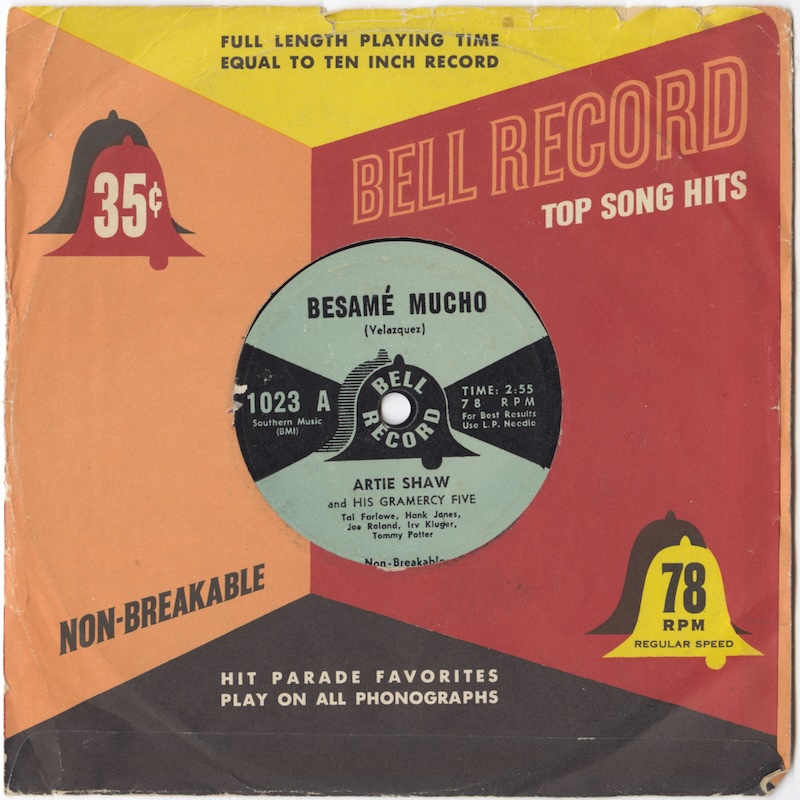
Besamé Mucho c/w That Old Feeling / Artie Shaw and His Gramercy Five (Bell 1023, 1953?)
from my own collection
7インチ45回転盤、10インチ78回転盤も同時発売されたが、これは7インチ78回転盤で、通常の78回転盤とは異なり、マイクログルーヴLP用の針で再生する
これも射出成形スチレン盤(レーベルは後貼り)
The introduction of this new Bell label gives rise to certain speculation. The ability to produce and sell profitably a nationally-distributed line of pop disks to sell at the low 35-cent price will undoubtedly be carefully watched by all segments of the trade. The use of the seven-inch, semi-microgroove disk reactivates speculation in this area. Several months ago Modern and its subsidiary, RPM, began shipping deejay copies of thsi type disk, although the latter were not injection molded. At that time there were recurring rumors in the trade that others would follow suit, Philips, the Dutch combine which recently entered the international record business, is pushing this type of platter.
この新しい Bell レーベルの登場により、ある憶測を生んでいる。35セントという低価格で販売されるポップ向けレコードを全国的に流通させ、採算の取れる形で生産・販売できるかどうかは、間違いなく業界のあらゆる分野から注意深く見守られることになるだろう。7インチのセミ・マイクログルーヴ盤の使用は、この分野での憶測を再燃させる。数ヶ月前、Modern レーベルとその傍系レーベルである RPM は、このタイプのディスクの DJ コピーの出荷を開始した(RPM レーベルのは射出成形ではなかったが)。当時、業界では他のメーカーも追随するという噂が繰り返し流れていたが、最近国際的なレコード・ビジネスに参入したオランダの企業グループ Philips は、このタイプの盤を推進している。
Another area of conjecture is that of injection molding. Tho the major labels are known to have experimented in this field only Golden Records has used this production method to any degree.
もう一つの推測は射出成形の分野である。大手レーベルがこの分野で実験を行ったことは知られているが、唯一 Golden Records だけがこの製造方法を使いこんでいる。
“NEW LOW-PRICE POPS: Book Firm Tests 35c Bell Records”, The Billboard, November 29, 195, p.19結局、この Bell レーベルは、1970年代に至るまで、射出成形45回転スチレン盤を積極的にリリースし続けることになります。
In the end, the Bell label continued to actively release injection-molded 45 rpm styrene records well into the 1970s.
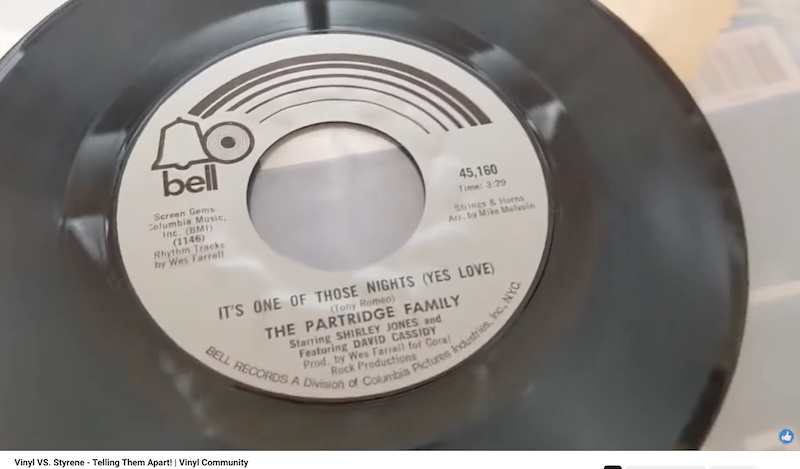
It’s One Of Those Nights (Yes Love) c/w One Night Stand / The Partridge Family (Bell 45160, 1972)
source: “Vinyl VS. Styrene – Telling Them Apart! | Vinyl Community”, That Vinyl Channel, YouTube.
レーベル紙の下に気泡が入り込んでいることで、プレス後レーベルが貼り付けられた、すなわちスチレン盤であることを示している
所感 / Observations
過去のニュース記事を時系列に追っていくことにより、1950年前後から射出成形スチレン盤への動きが本格化し、特にメジャーレーベルである Columbia が巨大投資を開始、射出成形での12インチLPの実現に向けて動き出していたことが分かりました。
By following past news articles chronologically, we learned that the movement towards injection-molded styrene records began in earnest around 1950, with major label Columbia in particular making huge investments and moving towards realizing the injection-molded 12-inch LP.
その一方で、1950年〜1953年の朝鮮戦争により、戦時体制のためレコード原材料が不足する懸念が重なっていたことも初めて知りました。
On the other hand, we also learned that the Korean War from 1950 to 1953 had created concerns about a shortage of raw materials for records due to the wartime system.
次回は、朝鮮戦争休戦後、米国で射出成形12インチLP盤が登場したものの、さまざまな理由から主流にはならなかった、その辺りをみていきます。
In my next article, I will look at how injection-molded 12-inch LP records appeared in the United States after the Korean War armistice, but for various reasons never became mainstream.
» 続き / Sequel: “How Records Were/Are Manufactured (4)” »

